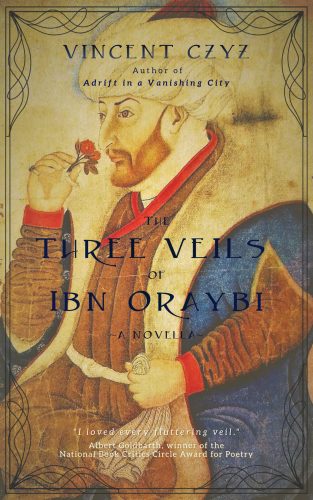Book Review: “The Three Veils of Ibn Oraybi” — A Lovely Exotic Fantasy
By Michael Marano
This is a lyrical work: gracefully exaggerating reality is a merit that good poetry and fantasy share.
The Three Veils of Ibn Oraybi by Vincent Czyz. Papillon du Père Publishing, 58 pages, $8.

I was waxing nostalgic, and was about to reread a beloved paperback original fantasy novel from my teenage years (featuring a big-ass dragon, no less) when, reminded of the deadline for this review, I reached for Vincent Czyz’s novella The Three Veils of Ibn Oraybi instead.
I’m glad I did.
In no way, shape, or form do I mean this in a dismissive or pejorative way: The Three Veils of Ibn Oraybi scratched the same aesthetic itch that a reread of that novel would have. It’s a lyrical work: gracefully exaggerating reality is a merit that good poetry and fantasy share. An earlier version of The Three Veils of Ibn Oraybi was published in the literary magazine Agni, and that was a fine home for it. An equally fine home for it would be to send it back in time to the ’30s. There it would find an appreciative readership in a pulp publication like Magic Carpet Stories, published by editor Farnsworth Wright. It would be sandwiched between offerings by Robert E. Howard and E. Hoffman Price.
I’ll avoid discussing the novella’s plot. The Three Veils of Ibn Oraybi features many of the narrative elements that make fantasy and pulps so appealing (great historical settings, assassination schemes, palace intrigues, alchemist laboratories, crafty brigands, forbidden romances, and the clash between the “civilized” and the “primitive” that so obsessed the aforementioned Mr. Howard). But at heart it is an aphorism. The work’s power lies in its narrative simplicity, and to focus on the story here would be to undermine that strength.
Suffice to say, the “three veils” of the title refer to three ways of looking at reality, based on three kinds of truth. In this respect, The Three Veils of Ibn Oraybi echoes the Sufi and Dervish yarns collected by Idries Shah. The story exists to waft away, a means to reveal a Greater Truth.
As happens in a good fantasy, there is a strong element of spirituality in the fable dramatized by The Three Veils of Ibn Oraybi. (At one point, a character’s soul steps outside his body to offer that character new perspectives on existence.) And, as in many such stories, The Three Veils of Ibn Oraybi is situated in a culture entering its twilight. The narrative takes place in Turkey during what is hinted to be the mid-to-late 19th century, an iteration of the Ottoman empire that is entering its endgame. This dusk setting, cradled between the traditional and the modern, the East and the West, the urban and the rustic, provides a perfectly gauzy light through which to view the book’s flickering veils. (Though, to my mind, there are confrontations with Westernization that echo some of the themes and story elements in Yukio Mishima’s Sea of Fertility series.)
It’s this delicately evoked twilight realm, drifting between two worlds, with its virile gleams of warrior heroism, that makes The Three Veils of Ibn Oraybi a prose work suitable for the readers of both Agni and Magic Carpet Stories. The fable ends on an appropriately apocalyptic note (literally, “The Lifting of the Veil”). When the final veil is raised the result is quite lovely, a surprising glint of moral steeliness replacing the warm exotic glitter.
Since 1990, Michael Marano (www.michaelmarano.com) has been covering film for the nationally syndicated Public Radio Satellite System program Movie Magazine International, which airs in 111 markets in the US and Canada. He has provided film reviews and pop culture commentary for a variety of national publications, and Tweets at @MikeMarano
Tagged: Papillon du Père Publishing, The Three Veils of Ibn Oraybi

